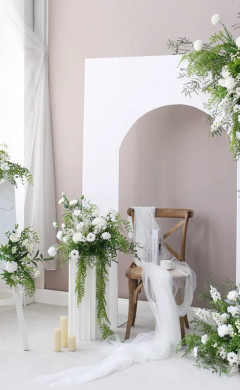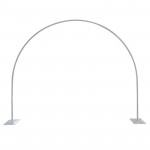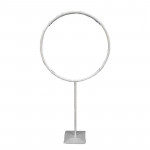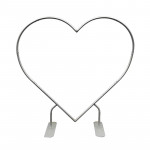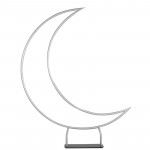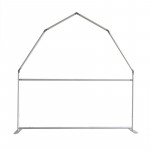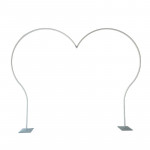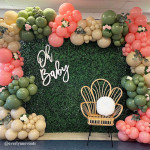Wedding & Party Flowers
Wedding Flower Glossary Illustrated
Flowers are essential to the atmosphere and décor of your wedding. They significantly add to the day's overall aesthetic and olfactory appeal. The bridal bouquet, a stunning arrangement of colors and flowers that capture your wedding's essence and theme, is just the start.
In addition to bouquets and boutonnieres, flowers can also be used as decorations for your wedding, like centerpieces and aisle decorations. Our helpful illustrated guide covers all you need to know about wedding flowers.
Who Needs Flowers In The Wedding Party?
The number of people requiring flowers may vary depending on how simple and affordable your wedding is. In a conventional wedding, flowers are expected for the parents, bridal party, bride, and groom. In addition to a distinctive bouquet, the bride might require a flower crown or some buds for her hair.
Bouquets will be needed for each bridesmaid and maid of honor, and boutonnieres will be necessary for the groom and each groomsman. Fathers and grandfathers will wear boutonnieres, while mothers and grandmothers of the bride and groom will wear corsages.
A flower girl and ring bearer are involved in a traditional wedding; they will both require flowers. The ring bearer needs flowers on his pillow and a boutonniere; the flower girl needs petals to throw and a flower crown or hairpiece. Any additional guests attending the wedding ceremony will require boutonnieres and corsages as appropriate.
You and your partner organize your wedding, whether a more contemporary, casual affair or a more conventional, formal one. Everything is up to your preference, including how many flowers you want. Make today genuinely yours because it's a particular day.
Which Flowers Are In Season?
The season of the flowers you choose for your wedding is crucial. When flowers are in season, they are more lovely, reasonably priced, and easier to find than when they are out of season. Spring and summer are popular times for weddings because of the nice weather and happy vibes. This is when many people choose to get married.
While some varieties of flowers are available all year round, the majority of popular flowers for weddings are seasonal. The fundamental list of flowers available each season is provided here.
Spring (March to May)
Calla Lily, Tulip, Hyacinth, Hydrangea, Lilac, Lily, Calla Lily, Rose, Sweet Pea, Iris, Orchid, Gerbera Daisy, Peony, Ranunculus, and Stephanotis
Summer (June to August)
Rose, Hydrangea, Bells of Ireland, Sunflower, Freesia, Orchid, Poppy, Snapdragon, Chrysanthemum, and Stephanotis
Fall (September to November)
Chrysanthemum, Rose, Calla Lily, Dahlia, Gerbera Daisy, and Stephanotis
Winter (December to February)
Carnations, Lilies, Orchids, Stephanotis, Gerbera Daisy, Roses, Tulips, and Ranunculus
You can still make a lovely bouquet for your fall or winter wedding. There may be fewer flowers to choose from than in spring and summer.
However, you can still create a beautiful arrangement. Don't worry about the limited selection. You can still have a stunning bouquet for your special day.
Plan your wedding flowers early by choosing your flowers, colors, and florist six to nine months before your wedding. This will ensure you and your florist have enough time to prepare.
Start by selecting the flowers you want and the colors you prefer. Then, find a florist who can bring your vision to life.
Popular Wedding Flowers
Though many thousands of different kinds of flowers worldwide, only a few are frequently used in weddings. These flowers are the most widely used for weddings due to their beauty, adaptability, and symbolic meaning.
The traditional symbol of romance and love is a rose. Roses are perfect for weddings because they are always available, come in a variety of colors, and symbolize love and beauty. They can be found throughout the year, making them a convenient choice for any wedding. With their wide range of colors, roses can easily match any wedding theme or color scheme.
Additionally, roses have long been associated with love and beauty, adding a romantic touch to any wedding celebration. Roses are only not advised as wedding flowers around Valentine's Day when the quality declines and prices increase.
Peonies are popular for wedding bouquets because of their vast, full heads and layers of ruffled petals. Peonies have been valued for generations; in Asia and Europe, they were first prized for their purported medical properties before their beauty was acknowledged.
Calla lilies are graceful, uncomplicated, and make stunning arrangements. They stand out from other wedding flowers thanks to their unusual shape. While creamy ivory is the most popular color, it also comes in stunning shades like orange and deep purple.
Gerbera daisies are a good option for a round wedding bouquet. They are strong and have a uniform shape. Additionally, they are available in a variety of colors. Gerbera daisies are an excellent option for a straightforward yet vibrant bouquet.
Gardenias are usually ivory white, and their single blooms look stunning by themselves or in a bouquet. They make a beautiful centerpiece when floating in a water bowl since they are particularly aromatic.
A stunning tropical flower, orchids come in several distinct species, all of which make exquisite choices for your bridal bouquets. Dendrobium and Vanda's orchids have more traditional flower forms, while Cymbidium and Phalaenopsis are typical, classic orchids. Whichever variety of orchids you choose for your wedding will give the occasion a touch of sophistication and elegance.
Hydrangeas make the perfect single-flower arrangement because of their clustered blossoms. They are among the few flowers available in blue and can also be pink or purple, depending on how acidic the soil is.
Ranunculus are a popular choice for weddings because they are cost-effective and look like roses and peonies. It is a valuable option that is available in a variety of hues for both bouquets and boutonnieres.
Widely available in various hues, tulips' uncomplicated form sets them apart from other flowers like baby's breath and roses in bouquets. They are perfect for formal and informal weddings because of their versatility.
The beautiful white Stephanotis flower looks great on its own or mixed with other flowers in a bouquet. These make lovely boutonniere flowers as well.
Casablanca lilies have large, flat blooms that are beautiful for tropical weddings and great for adding to bouquets. They come in various hues, smell amazing, and create beautiful images.
Popular Color Combinations
You might already have a color scheme chosen, depending on the topic of your wedding. Based on this color scheme, you can select the color combinations for your bouquets and centerpieces.
Your wedding flowers will make your big day even more beautiful. You can match your bouquet to your colors or use complementary hues to make them stand out. These are some of our favorite floral color combinations that are popular for weddings.
Mint green and peach
Burnt orange and burgundy
Lavender and light blue
Light pink and coral
Deep purple and magenta
Bright yellow and white
Types of Wedding Bouquets
All eyes will be on you as you proceed down the aisle. With your hair and veil artfully framing your face, everyone will wonder how stunning you look in your dress. The bridal bouquet that you are holding in your hands will also catch their attention.
Choosing the appropriate style for your wedding is essential since your gorgeous bridal bouquet serves as a statement piece that embodies your individuality. These are the many bouquets that most brides decide to carry as they go down the aisle.
Round
The perfect example of a traditional and classical bridal bouquet is a round bouquet. The spherical shape is usually achieved with little flowers, but you can use a variety of blooms if you'd like. The appearance is well-groomed and adaptable regarding matching dress codes, environments, and formality levels.
Composite
A variant of the classic round bouquet is a composite bouquet. Handmade flowers are made by wiring or gluing petals and buds together to look like a big flower. Typically, a single genuine flower serves as the focal point of the bouquet, with additional petals added to create the illusion. You'll want to pick flowers with thick, waxy petals that can withstand additional handling and adhesive for this bouquet.
Nosegay
A nosegay is a small bouquet that people can carry around. It comprises tightly clustered flowers and is frequently trimmed to a consistent length and ribbon-bound. A nosegay bouquet doesn't have to be round. It usually has a couple main flowers with filler flowers like baby's breath and leaves around them.
Usually, the bridesmaids carry smaller nosegay bouquets, while the bridal bouquet is more enormous. Another name for this kind of bouquet is a tussie-mussie.
Posy
Although they are a little smaller and more manageable to hold with one hand, posy bouquets resemble nosegay bouquets in many ways. They are ideal for bridesmaids or child attendants. Posy bouquets typically include lesser flowers along with leaves and herbs. You can also incorporate a few larger flowers to create a striking impact.
Pomander
A pomander sometimes called a kissing ball, is a bouquet of a foam ball covered in flowers and tied with ribbon for a handle. This is not typically used as a wedding bouquet but is a typical style for bridesmaids and flower girls. To obtain the complete, spherical shape of pomanders, it looks best to select flowers that are almost the same size.
Hand-Tied
To make a hand-tied bouquet, arrange the stems and greenery in a spiral pattern with your hands. Tie them together at the center so only the bottom of the stems show.
It is a fantastic option for outdoor or casual weddings because of its "rougher" and looser appearance. You can use any mix of flowers you like for this bridal bouquet. Wildflowers are great for hand-tied bouquets to get a rustic look.
Cascade
They named the cascade bouquet because it resembles a flower "waterfall" that overflows the bride's hands. It is typically seen at more formal weddings and is far more significant than most other bouquets. A path of mixed flowers and leaves is wired to cascade. Lilies, hyacinths, and orchids are popular flower choices for cascading bouquets.
Pageant
Long-stemmed flowers intended to be held in the bride's arms are called pageant bouquets. Another name for them is arm sheath bouquets. These are not designed to be carried, but rather held.
Use just a few flowers of the same kind to give a bouquet an attractive, formal appearance. Roses with long stems, calla lilies, and orchids are a few possibilities. This will give the arrangement a polished and unified appearance. Using a variety of flower varieties can make the bouquet appear less formal and congested.
Wedding Party Flowers Costs And Budget
Fresh flowers can be highly costly, particularly if you're seeking vast numbers of superior blooms. The bride's bouquet is the most detailed and costly. Wedding flower costs can range from $100 to $300. The price depends on the designer, as well as the type and amount of flowers chosen.
The expense of the smaller bridesmaid bouquets, which range from $75 to $100 each, adds up because you'll need to purchase several of them. While corsages usually cost between $15 and $25, each man's boutonniere costs between $10 and $20. They will also need flowers and petals if you have a flower girl or ring bearer. Depending on how many flowers you desire for each kid attendant, the cost of their flowers will range from $20 to $50.
Apart from the individuals who will need flowers, you'll probably want to include flowers in your décor. Arches, reception décor, centerpieces, and aisle decorations all look stunning when adorned with fresh flowers. They look lovely when added to the wedding cake, bridesmaids' hair, and other details.
You can decide how many flowers you want for your wedding. However, remember that the type and quantity you choose will impact the cost.
The cost of flowers can increase rapidly. Flower costs can add up quickly.
Without considering décor or reception flowers, the typical cost of bridal flowers is between $1,000 and 2,000 dollars. When planning your wedding flower budget, remember that some flowers are more expensive than others. Calla lilies, for instance, will cost more than regular roses.
The season, the area you reside in, and the florist you choose are further determining variables. You should set aside roughly 8% of your entire flower budget as a general guideline to assist your budget for them.
Many soon-to-be brides may be shocked by the cost of flowers. There are several ways to reduce the cost of your flower budget: do-it-yourself projects, purchasing in bulk, and purchasing artificial flowers.
If you are confident in your ability to handle flowers, DIY flower arrangements are a feasible choice. However, we only recommend this option if you have a significant green thumb.
In addition to being far less expensive than fresh flowers, fake flowers can look lovely. Combining artificial and natural flowers might be a fantastic, cost-effective option if you're not interested in using fake flowers. You can also purchase flowers in bulk from your florist. They may charge a fee for arranging and creating your floral displays.
Regarding your wedding bouquets, you can cut costs, but remember that fresh flowers must be kept cold and that you'll need a secure method to deliver them to the locati0n. Regarding your wedding flowers, take the path that best fits your preferences and requirements.
Questions To Ask Your Florist
You want to make sure you choose the best florist for your needs, just like you would with all your other wedding suppliers. Sit down with your florist and discuss any questions or concerns concerning your wedding before making any reservations. Bring pictures of your bridesmaids' outfits, wedding gowns, and any available table settings or color schemes. This will assist your florist in imagining the style of your wedding and the ideal combinations of flowers and colors.
